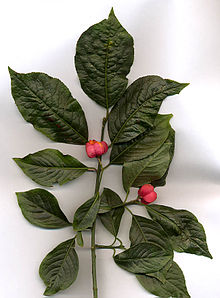Euonymus
| Euonymus | |
|---|---|

| |
| Euonymus europaeus foliage and fruit | |
| Scientific classification | |
| Kingdom: | |
| (unranked): | |
| (unranked): | |
| (unranked): | |
| Order: | |
| Family: | |
| Subfamily: | |
| Genus: | Euonymus |
| Species | |
|
See text | |
| Synonyms | |
|
Kalonymus (Beck) Prokh. | |
Euonymus (/[invalid input: 'icon']juːˈɒnɪməs/), often called spindle or spindle tree,[2] is a genus of flowering plants in the staff vine family, Celastraceae. It comprises about 170–180 species of deciduous and evergreen shrubs and small trees. They are mostly native to East Asia, extending to the Himalayas,[3] and they also have a distribution in Europe, Asia, Australasia, North America and Madagascar.
The flowers occur in small groups, inconspicuous and of green or yellow shades.[3] The leaves are opposite (rarely alternate) and simple ovoid, typically 2–15 cm long, and usually with a finely serrated margin.
The fruit is a pink-red four- or five-valved pod-like berry, which splits open to reveal the fleshy-coated orange seeds. The seeds are eaten by frugivorous birds, which digest the fleshy seed coat and disperse the seeds in their droppings. Many species are used for medicinal use, and parts of the plants can be poisonous to humans.[4]
Cultivation and uses

The wood of some species was traditionally used for the making of spindles for spinning wool; this use is the origin of the English name of the shrubs.
Spindles are popular garden shrubs, grown for their foliage, the deciduous species often exhibiting very bright red autumnal colours, and also for the decorative berries.
Selected species

References
- ^ "Genus: Euonymus L." Germplasm Resources Information Network. United States Department of Agriculture. 2007-10-05. Retrieved 2010-10-02.
- ^ Sunset Western Garden Book, 1995:606–607
- ^ a b Botanica: The Illustrated A-Z of over 10000 garden plants and how to cultivate them, p 358. Könemann, 2004. ISBN 3-8331-1253-0
- ^ Plants for a Future: Euonymus europaeus
